LTE/NR V2X Communication Modes and Future Requirements of Intelligent Transportation Systems Based on MR-DC Architectures
Abstract
:1. Introduction
2. 3GPP Vehicular Communication Standards
2.1. LTE and NR V2X Modes
2.2. LTE and NR Use Cases
- Vehicle platooning: refers to dynamically formed vehicle platoons. Thus, a lead vehicle transmits information to the vehicles that are part of the platoon. In addition, the surrounding vehicles can receive information from the platoon via Road Site Units (RSUs).
- Advanced driving: Both vehicles and RSUs can share data acquired by sensors to vehicles in their vicinity. Consequently, the vehicles can dynamically coordinate their trajectory.
- Extended sensors: exchange of sensor data or video information between vehicles, pedestrians, RSUs, servers, etc.
- Remote driving: use cases that allow remote operation of a vehicle either from a human operator or a V2X server.
3. Resource Management in LTE V2X Mode 4
- Step 1: CSRs are sensed in the sensing window which has a duration of 1000 ms, i.e., 1000 subframes or 1 s (see Figure 4). In this window, a vehicle selects all available CSRs, except those that, through the CSI, indicate that they have been reserved by other vehicles.
- Step 2: CSRs whose average Reference Signal Received Power (RSRP) is above a certain threshold are filtered out. This threshold is defined from higher layers and depends on the priority of the packets, which may be related to the type of V2V service being used. Note that this step excludes CSRs that are possibly being reserved or used by other surrounding vehicles.
- Step 3: It should be verified that the number of CSRs filtered in the previous step is at least 20% of the initially sensed CRSs. If this is not the case, then the threshold defined to measure the average RSRP is increased by 3 dB. Thus, step 3 is iteratively repeated until the condition of having at least 20% of CSRs available is met.
- Step 4: finally, 20% of the CSRs (filtered in step 3) that experience the lowest average Received Signal Strength Indicator (RSSI) of all RBs are filtered out. Thus, a CSR is randomly selected to be used for the first transmission.
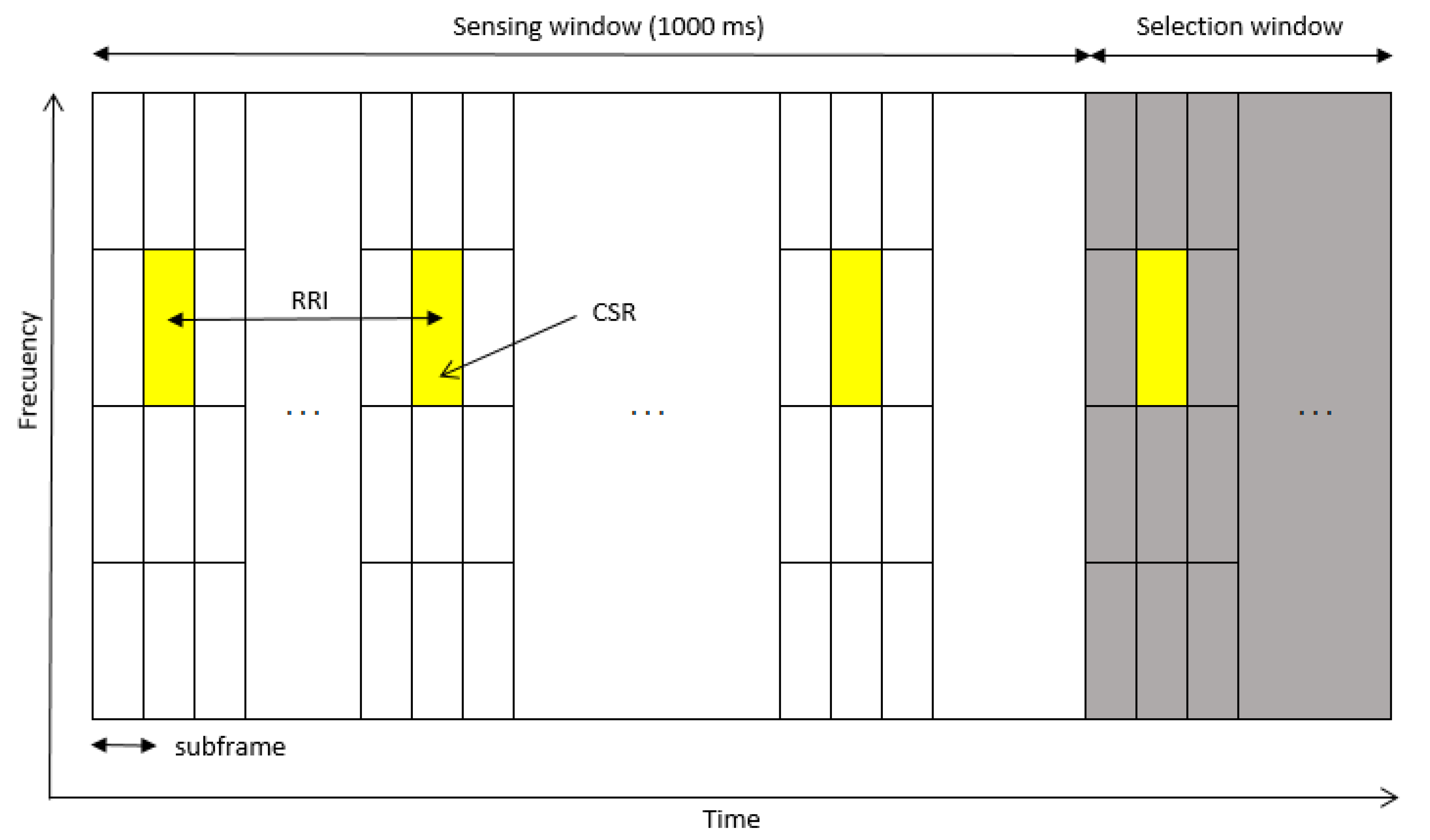
- The number of subchannels of a CSR that a vehicle must reserve depends on the length of the message to be transmitted. That is, it depends on the V2V use case to be used.
- The duration of the selection window depends on the latency requirements of V2V communications and has a maximum duration of 100 ms, i.e., 10 pps. In addition, sensing windows with a duration of 50 ms and 20 ms are possible for 20 pps and 50 pps, respectively [15].
- The vehicle can continue transmitting persistently after a certain number of packets. This number depends on a Reselection Counter (RC) that decrements depending on the transmission time of consecutive packets and is known as Resource Reselection Interval (RRI). The RC is randomly selected and can vary from [5, 15] for 10 pps, [10, 30] for 50 pps and [25, 75] for 50 pps. Note that there is persistent transmission for at least 1 s.
- Each time the RC decreases to zero, the resource selection and reservation process must be performed again, where the probability of keeping the previous resources varies between 0 and 0.8.
4. Performance Evaluation
4.1. LTE Mode 4
4.1.1. OMNeT++ Simulation Tool
4.1.2. Performance Results
4.2. LTE Mode 3
5. MR-DC Architectures for Multi-RAT V2X
- 1.
- Selection of multiple interfaces: use of NR PC5 in addition to the NR Uu interface communications (e.g., simultaneous transmissions via PC5 and Uu interface);
- 2.
- Dual RAT Uu transmissions: (NR and LTE Uu communications);
- 3.
- Multi-RAT: mutual inter-operation of NR and LTE sidelink communications;
- 4.
- Cross-RAT: coexistence of LTE and 5G sidelink with no inter-operation.
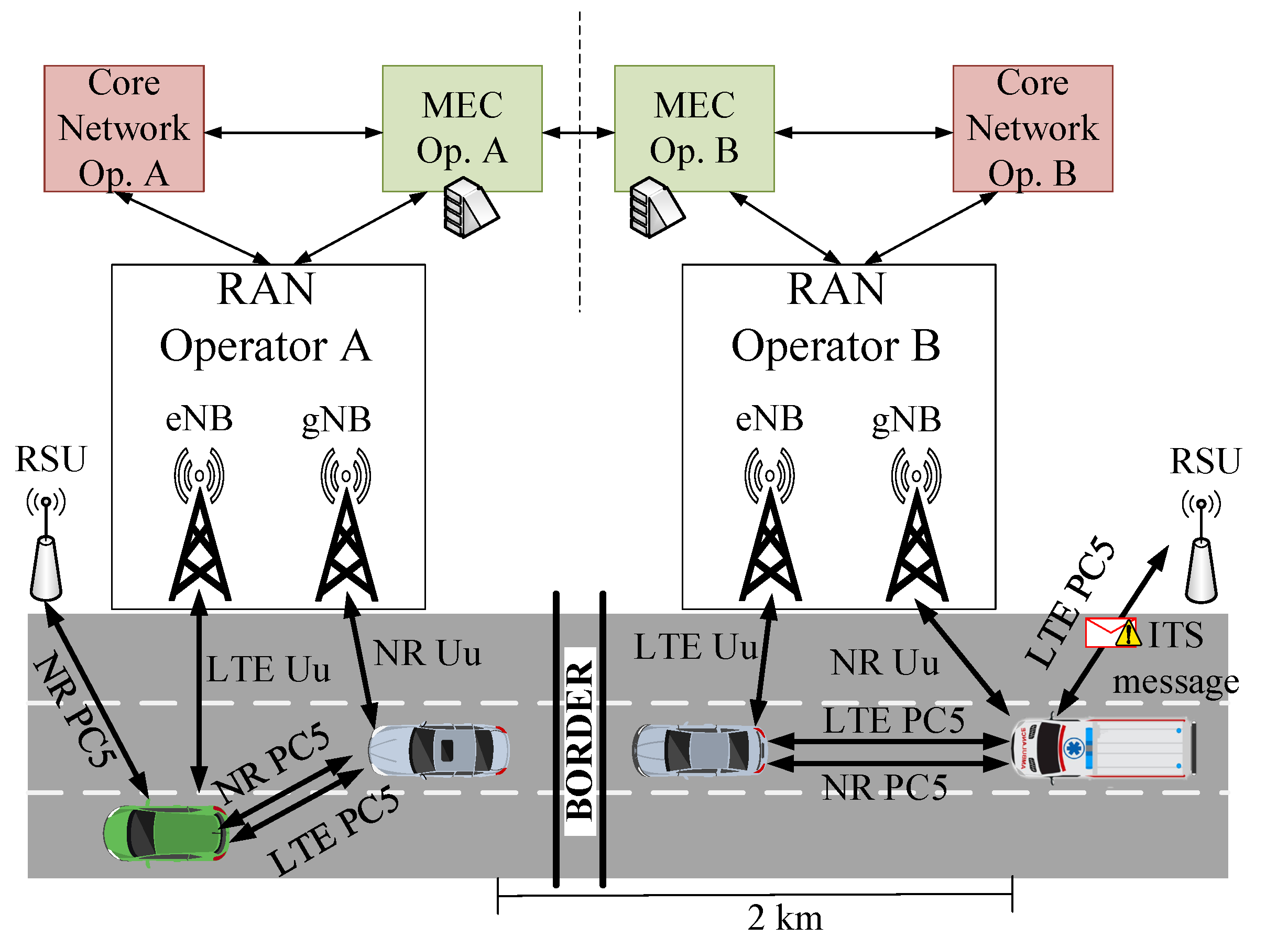
- 1.
- NR-E-UTRA Dual Connectivity (NE-DC): standalone gNB, a 5G NR node, connected to the 5G Core (5GC), and sidelink communications controlled/configured by the MN (a 5G gNB);
- 2.
- NG-RAN E-UTRA-NR Dual Connectivity (NGEN-DC): standalone next-generation eNB (ng-eNB), which is an E-UTRAN node (LTE radio) with the capability to connect to the 5GC, and sidelink communications controlled/configured by ng-eNB (MN);
- 3.
- E-UTRAN NR Dual Connectivity (EN-DC): standalone LTE eNB connected to the Evolved Packet Core (EPC), and sidelink communications controlled/configured by eNB (MN).
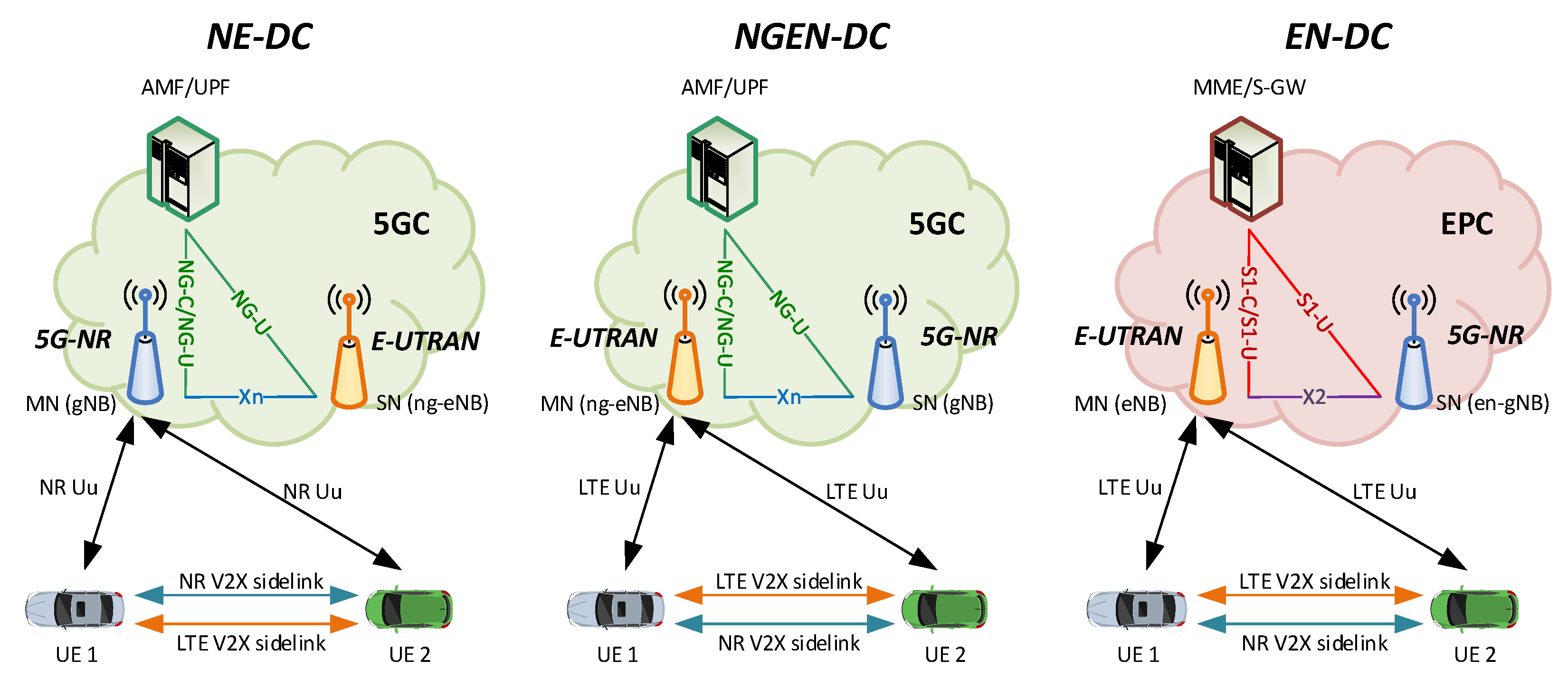
6. Conclusions and Future Work
Author Contributions
Funding
Institutional Review Board Statement
Informed Consent Statement
Data Availability Statement
Conflicts of Interest
References
- Sachse, T.; Gräbner, O.; Möckel, M.; Kaschwich, C.; Plättner, J. Intelligent traffic control and optimization with cooperative systems on the eHighway: Using the electrified highway-infrastructure for heavy good vehicles and the advanced traffic control center with V2X for a more efficient and safer traffic (for all road users). In Proceedings of the 2014 International Conference on Connected Vehicles and Expo (ICCVE), Vienna, Austria, 3–7 November 2014; pp. 558–564. [Google Scholar] [CrossRef]
- Tal, I.; Zhu, T.; Muntean, G.M. Short paper: On the potential of V2X communications in helping electric bicycles saving energy. In Proceedings of the 2013 IEEE Vehicular Networking Conference, Boston, MA, USA, 16–18 December 2013; pp. 218–221. [Google Scholar] [CrossRef]
- Kenney, J.B. Dedicated Short-Range Communications (DSRC) Standards in the United States. Proc. IEEE 2011, 99, 1162–1182. [Google Scholar] [CrossRef]
- 3GPP TSG SA. Study on LTE Support for Vehicle-To-Everything (V2X) Services. TR 22.885 V14.0.0, 3GPP. 2015. Available online: https://portal.3gpp.org/desktopmodules/Specifications/SpecificationDetails.aspx?specificationId=2898 (accessed on 20 February 2022).
- 3GPP TSG SA. Study on Enhancement of 3GPP Support for 5G V2X Services. TR 22.886 V16.2.0, 3GPP. 2018. Available online: https://portal.3gpp.org/desktopmodules/Specifications/SpecificationDetails.aspx?specificationId=3108 (accessed on 20 February 2022).
- Garcia-Roger, D.; González, E.E.; Martín-Sacristán, D.; Monserrat, J.F. V2X Support in 3GPP Specifications: From 4G to 5G and Beyond. IEEE Access 2020, 8, 190946–190963. [Google Scholar] [CrossRef]
- 3GPP TSG RAN. Evolved Universal Terrestrial Radio Access (E-UTRA) and NR; Multi-Connectivity; Stage 2. TS 37.340 V16.3.0, 3GPP. 2020. Available online: https://portal.3gpp.org/desktopmodules/Specifications/SpecificationDetails.aspx?specificationId=3198 (accessed on 20 February 2022).
- 3GPP TSG RAN. Evolved Universal Terrestrial Radio Access (E-UTRA); Physical Layer Procedures. TS 36.213 V16.5.0, 3GPP. 2021. Available online: https://portal.3gpp.org/desktopmodules/Specifications/SpecificationDetails.aspx?specificationId=2427 (accessed on 20 February 2022).
- 3GPP TSG RAN. Study on NR Vehicle-to-Everything (V2X). TR 38.885 V16.0.0, 3GPP. 2019. Available online: https://portal.3gpp.org/desktopmodules/Specifications/SpecificationDetails.aspx?specificationId=3497 (accessed on 20 February 2022).
- Naik, G.; Choudhury, B.; Park, J. IEEE 802.11bd & 5G NR V2X: Evolution of Radio Access Technologies for V2X Communications. arXiv 2019, arXiv:1903.08391. [Google Scholar]
- CAR 2 CAR Communication Consortium. Guidance for Day 2 and Beyond Roadmap; Technical Report. 2019. Available online: https://www.car-2-car.org/fileadmin/documents/General_Documents/C2CCC_WP_2072_RoadmapDay2AndBeyond.pdf (accessed on 20 February 2022).
- Mansouri, A.; Martinez, V.; Härri, J. A First Investigation of Congestion Control for LTE-V2X Mode 4. In Proceedings of the 2019 15th Annual Conference on Wireless On-demand Network Systems and Services (WONS), Wengen, Switzerland, 22–24 January 2019; pp. 56–63. [Google Scholar] [CrossRef]
- 3GPP TSG RAN. Evolved Universal Terrestrial Radio Access (E-UTRA) and Evolved Universal Terrestrial Radio Access Network (E-UTRAN); Overall Description; Stage 2. TS 36.300 V16.5.0, 3GPP. 2021. Available online: https://portal.3gpp.org/desktopmodules/Specifications/SpecificationDetails.aspx?specificationId=2430 (accessed on 20 February 2022).
- Molina-Masegosa, R.; Gozalvez, J. LTE-V for Sidelink 5G V2X Vehicular Communications: A New 5G Technology for Short-Range Vehicle-to-Everything Communications. IEEE Veh. Technol. Mag. 2017, 12, 30–39. [Google Scholar] [CrossRef]
- 3GPP TSG RAN. Evolved Universal Terrestrial Radio Access (E-UTRA); Medium Access Control (MAC) Protocol Specification. TS 36.321 V16.4.0, 3GPP. 2021. Available online: https://portal.3gpp.org/desktopmodules/Specifications/SpecificationDetails.aspx?specificationId=2437 (accessed on 20 February 2022).
- Nabil, A.; Marojevic, V.; Kaur, K.; Dietrich, C.B. Performance Analysis of Sensing-Based Semi-Persistent Scheduling in C-V2X Networks. arXiv 2018, arXiv:1804.10788. [Google Scholar]
- Chen, M.; Chai, R.; Hu, H.; Jiang, W.; He, L. Performance Evaluation of C-V2X Mode 4 Communications. In Proceedings of the 2021 IEEE Wireless Communications and Networking Conference (WCNC), Nanjing, China, 29 March–1 April 2021; pp. 1–6. [Google Scholar] [CrossRef]
- Eckermann, F.; Kahlert, M.; Wietfeld, C. Performance Analysis of C-V2X Mode 4 Communication Introducing an Open-Source C-V2X Simulator. arXiv 2019, arXiv:1907.09977. [Google Scholar]
- McCarthy, B.; O’Driscoll, A. OpenCV2X Mode 4: A Simulation Extension for Cellular Vehicular Communication Networks. In Proceedings of the 2019 IEEE 24th International Workshop on Computer Aided Modeling and Design of Communication Links and Networks (CAMAD), Limassol, Cyprus, 11–13 September 2019; pp. 1–6. [Google Scholar] [CrossRef]
- Sempere-García, D.; Sepulcre, M.; Gozalvez, J. LTE-V2X Mode 3 scheduling based on adaptive spatial reuse of radio resources. Ad Hoc Netw. 2021, 113, 102351. [Google Scholar] [CrossRef]
- 3GPP TSG RAN. Study on LTE-Based V2X Services. TR 36.885 V14.0.0, 3GPP. 2016. Available online: https://portal.3gpp.org/desktopmodules/Specifications/SpecificationDetails.aspx?specificationId=2934 (accessed on 20 February 2022).
- OMNeT++—Discrete Event Simulator. 2021. Available online: https://omnetpp.org/ (accessed on 21 May 2021).
- SimuLTE—LTE User Plane Simulation Model for INET & OMNeT++. 2021. Available online: https://simulte.com/index.html (accessed on 21 May 2021).
- INET Framework. 2021. Available online: https://inet.omnetpp.org/ (accessed on 21 May 2021).
- Veins—The Open Source Vehicular Network Simulation Framework. 2021. Available online: https://veins.car2x.org/ (accessed on 21 May 2021).
- SUMO—Simulation of Urban MObility. 2021. Available online: https://www.eclipse.org/sumo/ (accessed on 21 May 2021).
- 3GPP TSG SA. Service Requirements for Enhanced V2X Scenarios. TS 22.186 V16.2.0, 3GPP. 2019. Available online: https://portal.3gpp.org/desktopmodules/Specifications/SpecificationDetails.aspx?specificationId=3180 (accessed on 20 February 2022).
- 5G-CARMEN. 2022. Available online: https://5gcarmen.eu/ (accessed on 15 March 2022).
- 5G New Radio User Plane Simulation Model for INET & OMNeT++. 2022. Available online: http://simu5g.org/ (accessed on 16 March 2022).
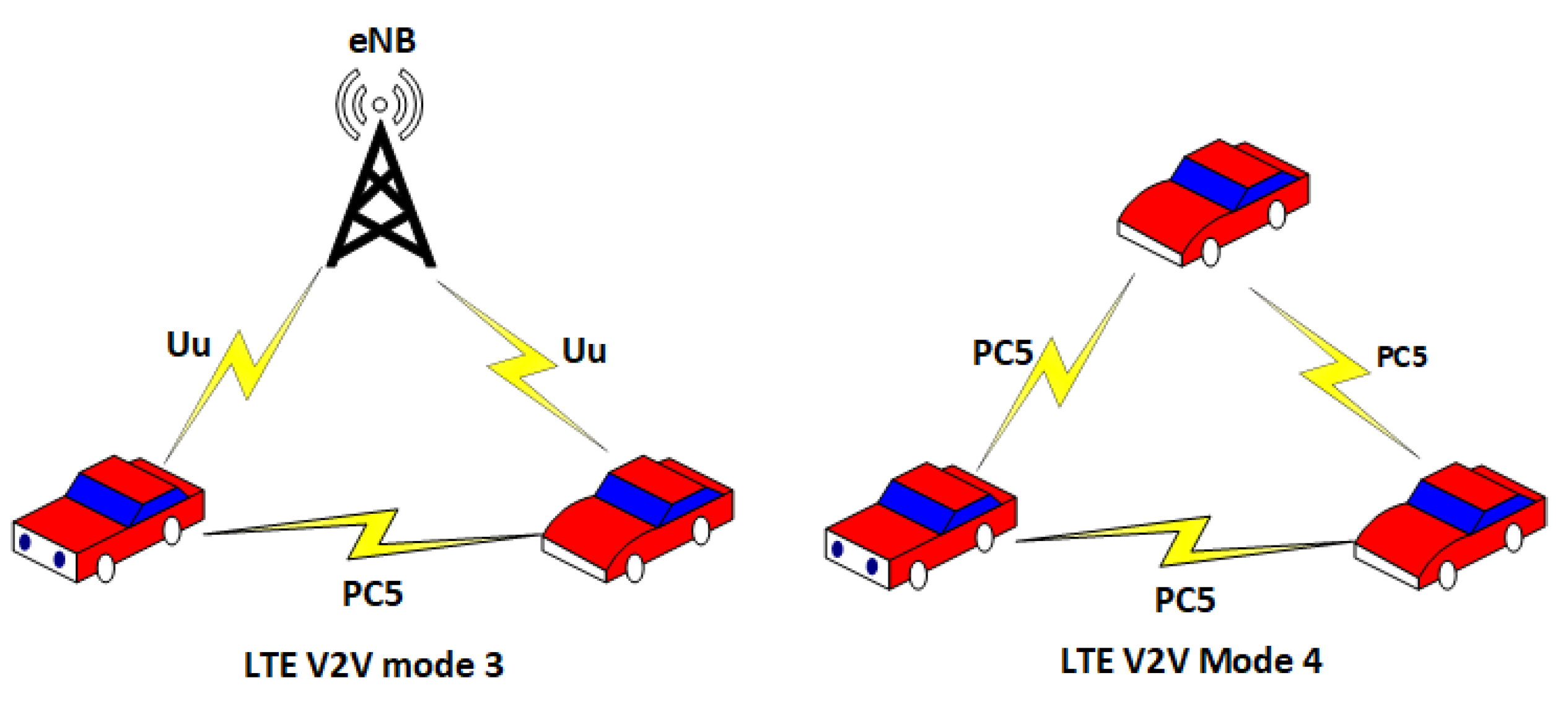


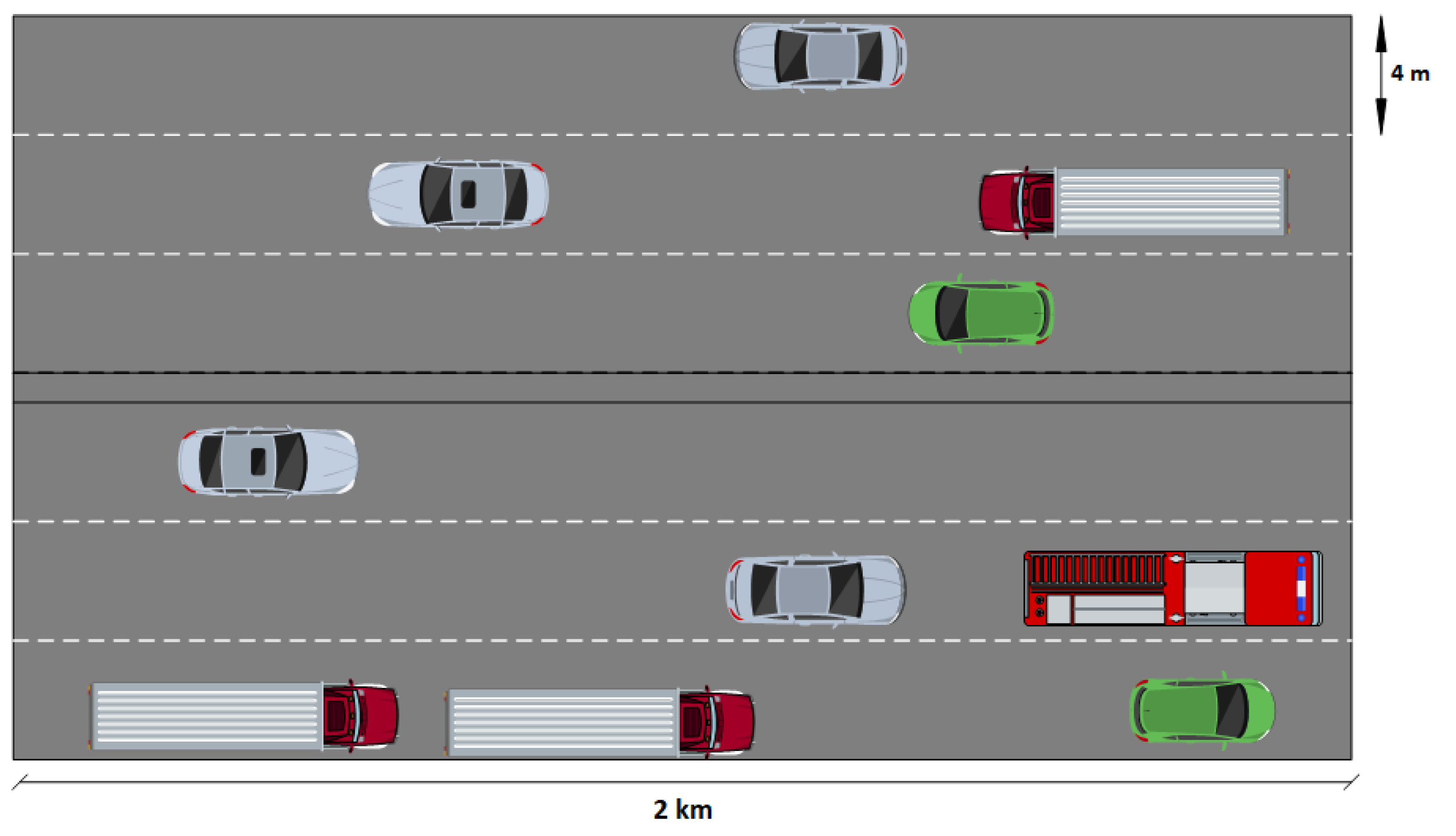

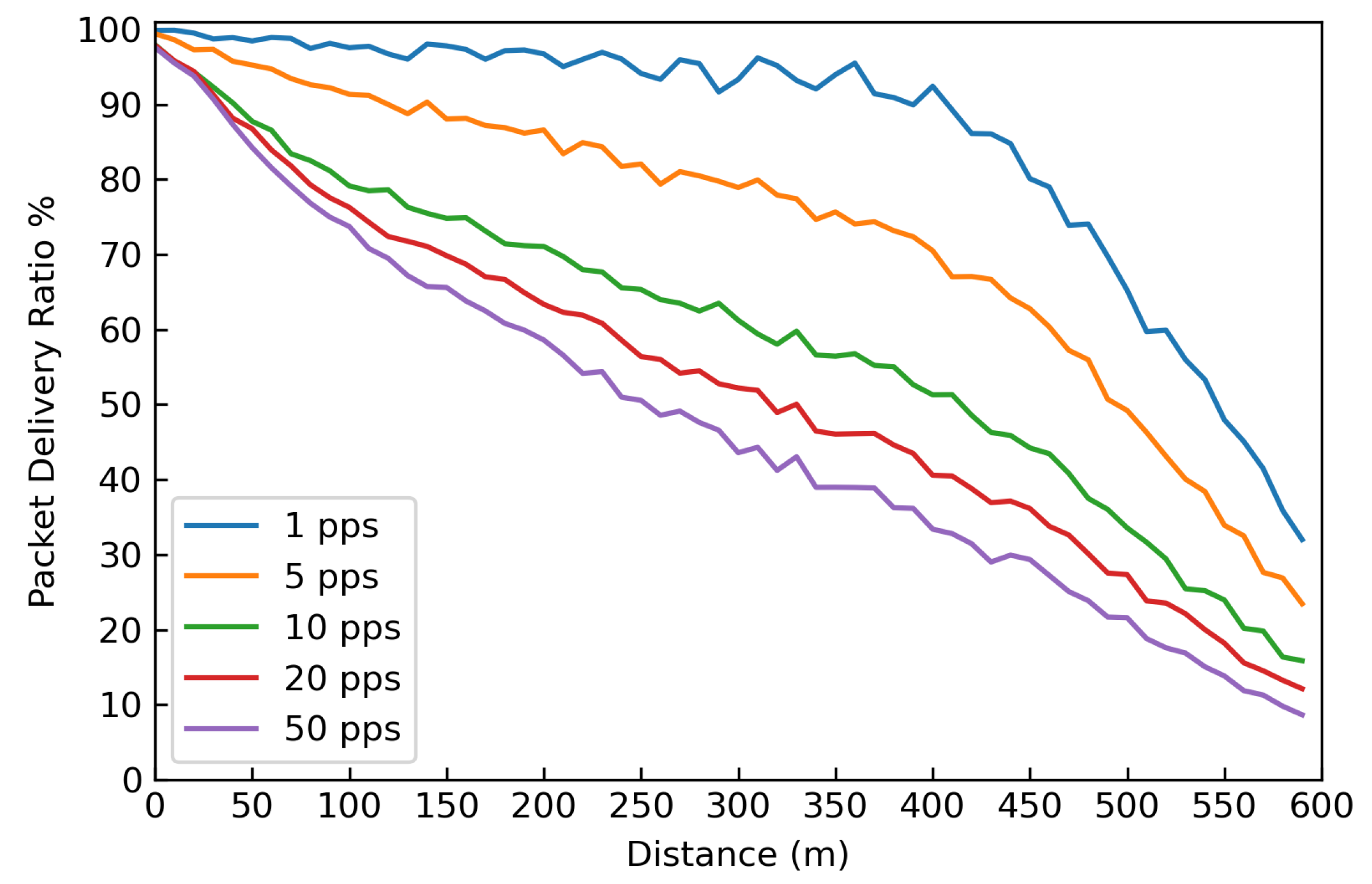
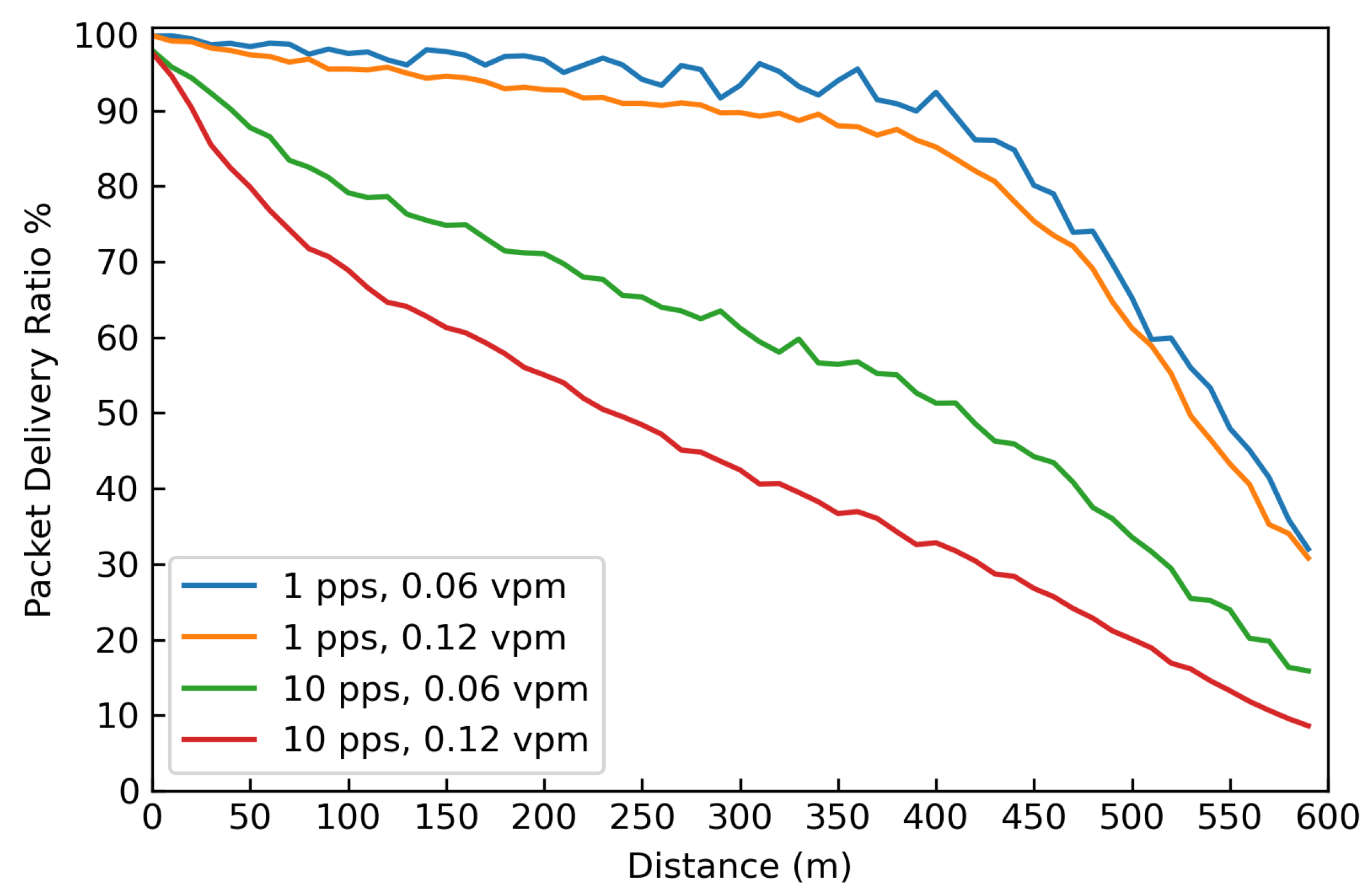
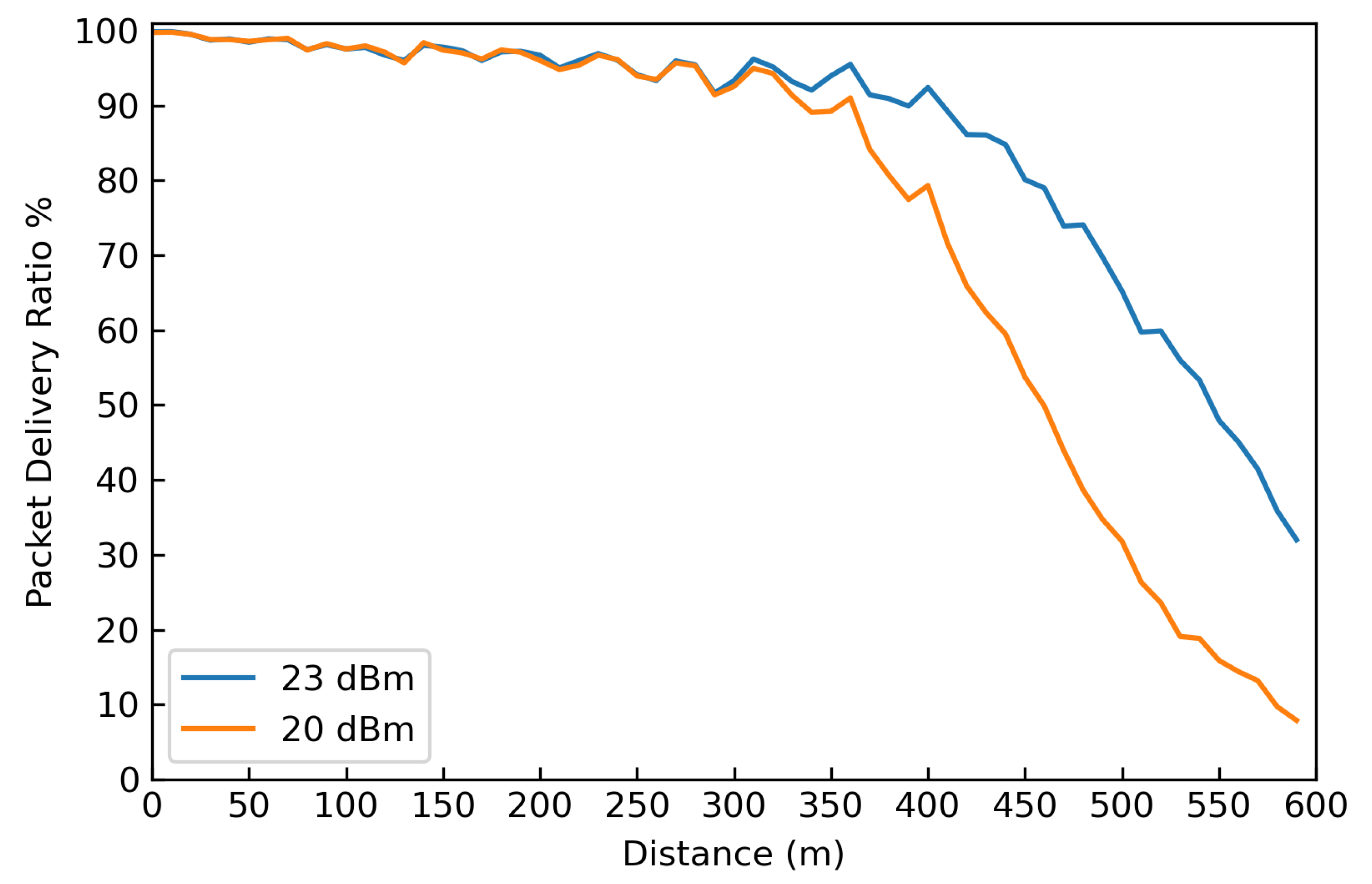
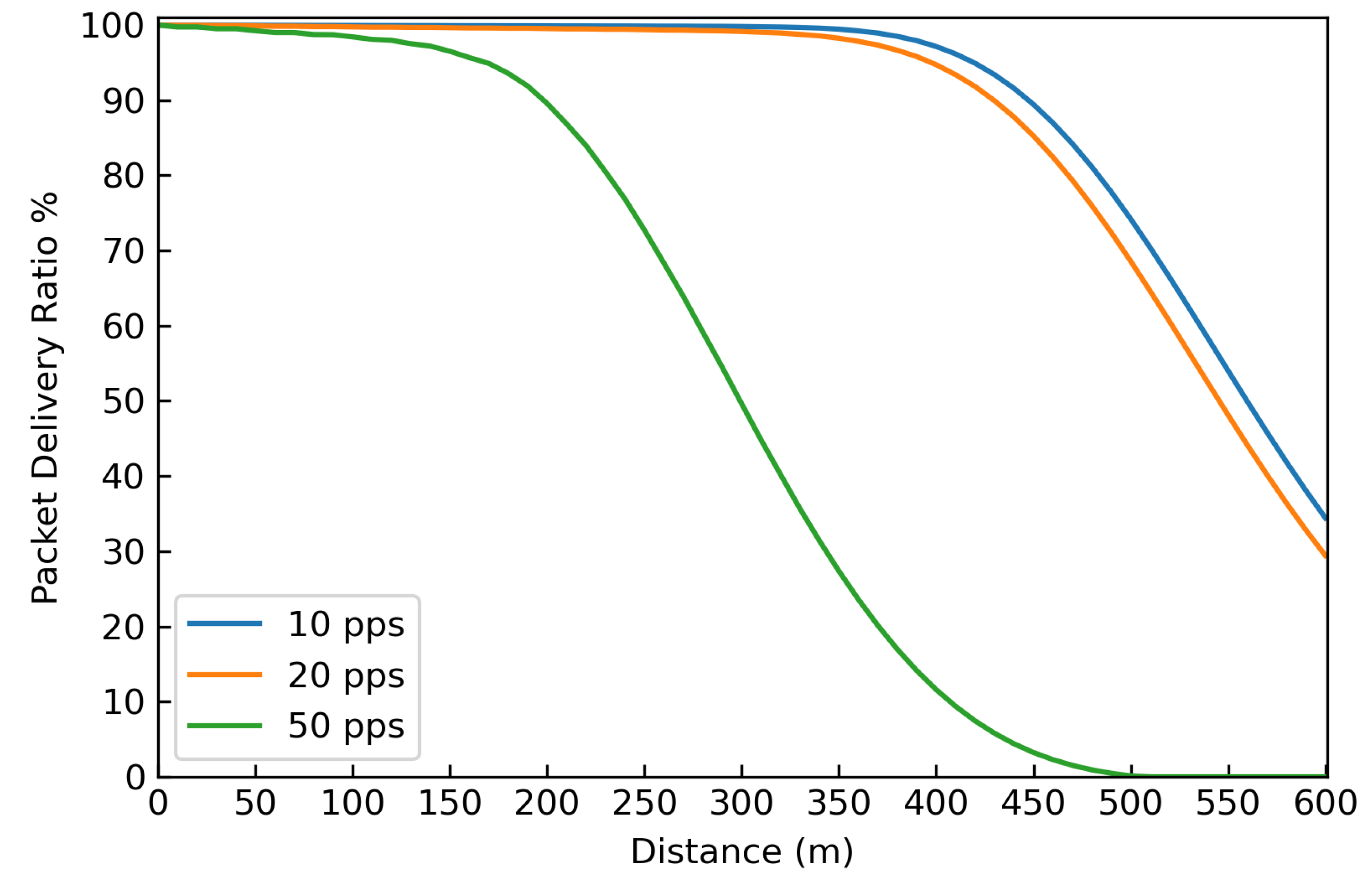
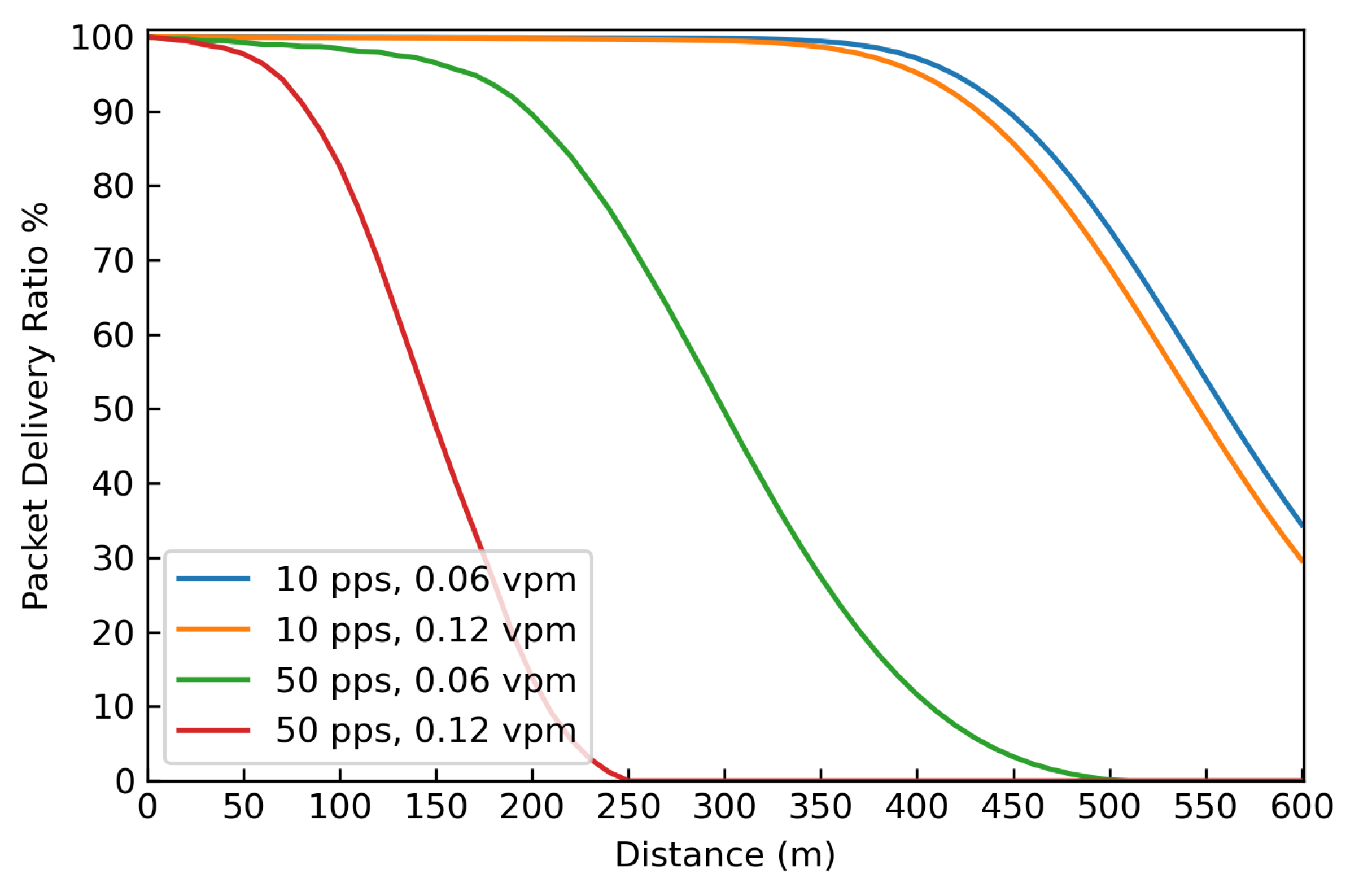

| Use Case | Latency | Packet Size | Packet Transmission |
|---|---|---|---|
| (ms) | (Bytes) | Rate—Max. (pps) | |
| Forward Collision Warning | 100 | 50–300 | 10 |
| Emergency vehicle warning | 100 | 50–1200 | 10 |
| Emergency Stop | 100 | 1200 | 10 |
| Queue Warning | 100 | 1200 | - |
| Automated Parking System | 100 | 50–400 | - |
| Pre-crash Sensing Warning | 20 | 50–300 | - |
| V2N Traffic Flow Optimization | 1000 | 50–300 | 1 |
| Road safety services | 100 | 300 | 10 |
| Use Case Group | Max. | Packet | Relia- | Data | Min. |
|---|---|---|---|---|---|
| Latency | Size | bility | Rate | Range | |
| (ms) | (Bytes) | (%) | (Mbps) | (Meters) | |
| Vehicle Platooning | 10–500 | 50–6000 | 90–99.99 | 50–65 | 80–350 |
| Advanced Driving | 3–100 | 300–12,000 | 90–99.999 | 10–50 | 360–500 |
| Extended Sensors | 3–100 | 1600 | 90–99.999 | 10–1000 | 50–1000 |
| Remote Driving | 5 | - | 99.999 | UL: 25 | - |
| DL: 1 |
| Parameter | Value |
|---|---|
| Carrier frequency | 5.9 GHz [21] |
| Channel bandwidth | 10 MHz [21] |
| Packet size | 190 Bytes [21] |
| PSCCH, PSSCH | Adjacent |
| Simulation time | 12 s |
| Vehicle density | 0.06, 0.12 vpm |
| Sensing window | 1000 ms |
| ProbResourceKeep | 0.4 |
| SubChannel size | 14 |
| Num. SubChannels | 2 |
| RSRP threshold | −128 dBm |
| RSSI threshold | −92 dBm |
Publisher’s Note: MDPI stays neutral with regard to jurisdictional claims in published maps and institutional affiliations. |
© 2022 by the authors. Licensee MDPI, Basel, Switzerland. This article is an open access article distributed under the terms and conditions of the Creative Commons Attribution (CC BY) license (https://creativecommons.org/licenses/by/4.0/).
Share and Cite
González, E.E.; Garcia-Roger, D.; Monserrat, J.F. LTE/NR V2X Communication Modes and Future Requirements of Intelligent Transportation Systems Based on MR-DC Architectures. Sustainability 2022, 14, 3879. https://doi.org/10.3390/su14073879
González EE, Garcia-Roger D, Monserrat JF. LTE/NR V2X Communication Modes and Future Requirements of Intelligent Transportation Systems Based on MR-DC Architectures. Sustainability. 2022; 14(7):3879. https://doi.org/10.3390/su14073879
Chicago/Turabian StyleGonzález, Edgar E., David Garcia-Roger, and Jose F. Monserrat. 2022. "LTE/NR V2X Communication Modes and Future Requirements of Intelligent Transportation Systems Based on MR-DC Architectures" Sustainability 14, no. 7: 3879. https://doi.org/10.3390/su14073879








